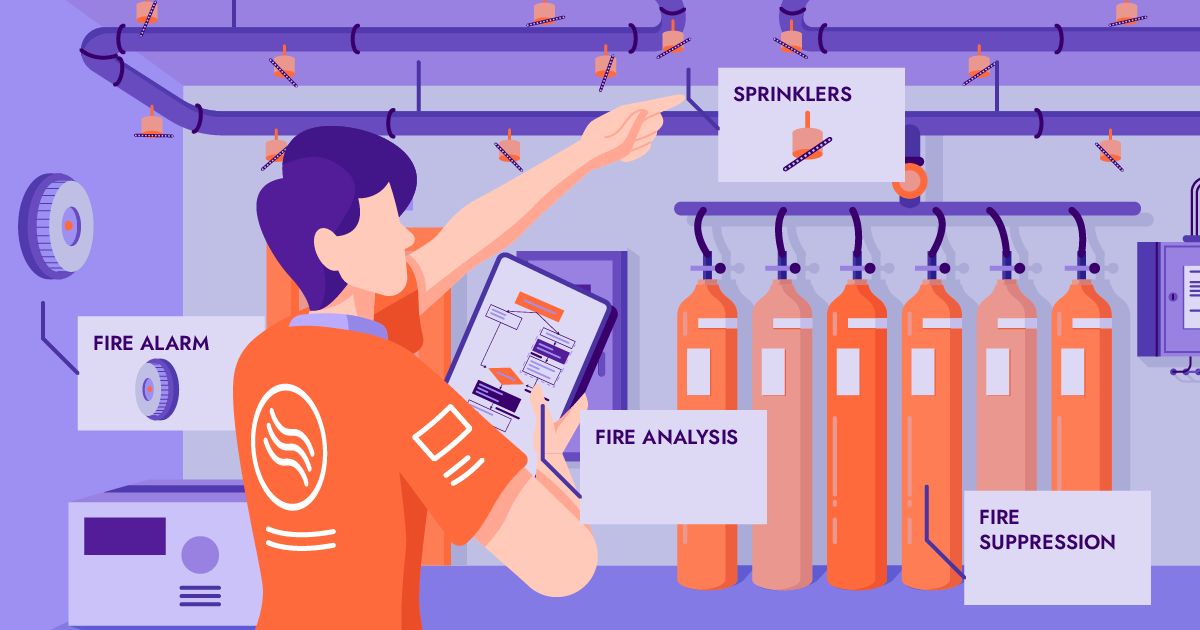Asset Life Cycle Management: Extending the Lifespan of Fire Safety Equipment

The meticulous management of fire assets is critical to ensuring both compliance with ever-evolving regulations and the longevity of essential equipment. As professionals committed to the safety of lives and property, you understand the multifaceted challenges posed by fire compliance and maintenance. And we understand how frustrating it can be when things just don’t go to plan. Whether that is data that needs to be manually entered, assets with defects that never get recorded, or simply a team that just isn’t on the same page.
fire protection services offering insights and solutions to extend the lifespan of your fire assets.
Understanding the Fire Compliance and Maintenance Landscape
Ensuring the safety of lives and property hinges on a delicate interplay between stringent compliance measures and meticulous maintenance practices. There are two main points that you need to consider:
1. Navigating Regulatory Changes:
The landscape of fire compliance is dynamic, with regulations evolving to address emerging risks. ALCM empowers fire protection services to stay ahead by integrating compliance management into asset life cycles. Regular audits, documentation updates, and swift adaptation to regulatory changes become seamless with a proactive ALCM approach.
2. Fire Assets in Focus:
Fire assets encompass a broad spectrum of equipment, from fire extinguishers to suppression systems. ALCM allows for a granular focus on each asset, ensuring that maintenance schedules, compliance checks, and technological integrations are tailored to the specific needs of individual fire assets.
The Role of Asset Life Cycle Management in Fire Protection Services
The efficient management of assets is not just a strategic consideration, it is the backbone of ensuring safety and operational effectiveness.
Fire assets demand a proactive approach to maintenance. By adhering to rigorous maintenance schedules based on ALCM principles, fire protection services can detect potential issues before they escalate. Regular inspections, lubrication, and component replacements become integral to enhancing fire safety and compliance.
Technology plays a pivotal role in modern fire asset management. Integrating IoT sensors and predictive maintenance software provides real-time insights into equipment health. Fire protection services can leverage this data to predict potential failures, allowing for preemptive action and minimizing downtime.
Common Problems in Fire Asset Management
We’ve all been there and struggled with key problems that just seem to keep repeating themselves. Whether big or small, there are some common bugbears that affect the fire protection industry:
Strategic Compliance Management:
ALCM enables fire protection services to strategically integrate compliance management into their operations. By aligning asset management strategies with compliance requirements, organizations can mitigate the risk of non-compliance, ensuring that fire assets adhere to the latest standards.
Downtime Mitigation Strategies for Uninterrupted Services:
Unplanned downtime is a significant pain point in fire protection services. ALCM offers strategies to mitigate downtime by combining proactive maintenance with predictive analytics. Redundancy measures, rapid response protocols, and strategic asset placement contribute to the uninterrupted delivery of fire protection services.
Cost-Effective Asset Management Strategies:
ALCM provides a framework for optimizing costs associated with fire assets without compromising safety. Through a comprehensive analysis of the total cost of ownership, fire protection services can implement cost-effective maintenance strategies, striking a balance between budget constraints and operational efficiency.
Training and Skill Development for Effective Fire Asset Management
Fire protection services rely heavily on the skills and expertise of their personnel. ALCM encourages investment in training and skill development programs. Well-trained technicians are better equipped to detect early signs of wear and tear, ensuring that fire assets are handled with care and proficiency.
Strategic Asset Replacement for Long-Term Viability
Asset Life Cycle Management (ALCM) introduces a proactive dimension to asset replacement strategies by advocating for a comprehensive life cycle analysis. This entails evaluating the entire life span of fire assets, from procurement to retirement, to make informed and strategic decisions regarding their replacement.
Here are the 8 keys to extending the life cycle of fire assets:
1. Initial Assessment and Procurement:
The life cycle analysis begins with a meticulous assessment during the procurement phase. Fire protection services should consider factors such as the expected lifespan of the asset, manufacturer recommendations, and technological advancements. This initial evaluation sets the stage for the entire life cycle.
2. Regular Health Check-ups:
Implementing regular health check-ups throughout the asset’s operational life is crucial. These assessments involve monitoring performance, wear and tear, and compliance adherence. By conducting periodic evaluations, fire protection services can identify signs of deterioration early on and plan for replacement before critical failures occur.
3. Adapting to Technological Advancements:
Technology in the fire protection industry is continually evolving. ALCM encourages fire protection services to stay abreast of technological advancements. If newer technologies offer improved safety features, efficiency, or compliance adherence, it may be strategically advantageous to replace older assets with newer, more advanced models.
4. Predictive Analytics for Performance Projections:
Integrating predictive analytics into life cycle analysis allows fire protection services to project the future performance of assets. By analyzing historical data, organizations can predict potential points of failure and plan for strategic replacements before assets become unreliable or non-compliant.
5. Budgetary Planning for Replacement Cycles:
ALCM encourages fire protection services to incorporate asset replacement cycles into their budgetary planning. By allocating funds specifically for replacement purposes, organizations can avoid financial strains when the time comes to retire aging assets. This strategic financial planning ensures a seamless transition to new equipment.
6. Environmental Impact Assessment:
Consideration of the environmental impact is an integral part of life cycle analysis. Fire protection services should assess the environmental implications of retiring and replacing assets. This involves proper disposal or recycling methods, ensuring compliance with environmental regulations, and contributing to sustainable practices.
7. Collaboration with Manufacturers and Suppliers:
Establishing strong partnerships with manufacturers and suppliers is essential for accessing updated information on asset performance and advancements. Collaborative relationships can provide insights into recommended replacement timelines, upcoming technologies, and potential discounts or incentives for timely replacements.
8. Documentation and Record-Keeping:
Comprehensive documentation and record-keeping are fundamental to effective life cycle analysis. Maintaining detailed records of each asset’s history, including maintenance activities, repairs, and compliance assessments, facilitates informed decision-making. It also aids in predicting future replacement needs based on historical performance data.
Optimizing fire compliance and maintenance through ALCM is not only a best practice but a strategic imperative for fire protection services.
In an industry where compliance and reliability are non-negotiable, effective ALCM emerges as the cornerstone for success, setting fire protection services on a trajectory of sustained excellence.
How FieldInsight Can Help:
- Streamlined Compliance Management: FieldInsight integrated compliance management into your workflow, ensuring that your fire assets consistently adhere to the latest standards. Stay ahead of regulatory changes with ease and confidence.
- Proactive Maintenance Planning: Take advantage of FieldInsight’s advanced features for scheduling and tracking routine maintenance. Proactively address issues before they lead to downtime, enhancing the overall safety and reliability of your fire protection services.
- Real-Time Asset Monitoring: FieldInsight incorporates real-time monitoring capabilities, providing instant insights into the health of your fire assets. Predictive analytics help you identify potential issues early, allowing for timely interventions.
- Efficient Job Management: Simplify your day-to-day operations with FieldInsight’s job management capabilities. From scheduling to dispatching and tracking, optimize your workflow to enhance overall efficiency.
By adopting a proactive approach through Asset Life Cycle Management (ALCM), you empower your business to navigate the complexities of compliance, mitigate downtime, and optimize costs while extending the lifespan of your fire assets.
What You Should Do Now
- Book a Demo. You’ll be in touch with an automation expert who has worked in this space for over 5 years, and knows the optimal workflow to address your needs.
- If you’d like access to free articles about managing HVAC workflows, go to our blog.
- If you know someone who’d enjoy reading this page, share it with them via email, Linkedin, Twitter, or Facebook.






